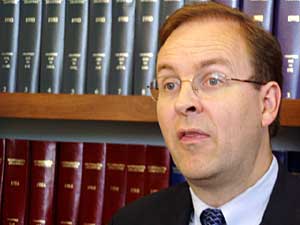Photos
More from MPR
Your Voice
| ||||||||||||||||||||||||||||||||||||
Below the political radar, plenty of contested races develop
August 15, 2004
All eyes may be on the race for the White House, but Minnesota has a full slate of other races to watch this year. The state's eight congressional seats are up, as are all 134 spots in the state House of Representatives. Republicans currently enjoy a substantial 28 seat majority in that body. That's the biggest edge the GOP has ever held in the House, since partisan elections were introduced in 1972. But Democrats say that's no reason the advantage can't be flipped in November.
St. Paul, Minn. — With an 81-to-53 seat majority in the House, the GOP controls a whopping one-and-a-half times as many seats as the minority Democrats, as solid a majority as a politician could hope for. Speaker Steve Sviggum, who leads the House Majority, recognizes his caucus probably doesn't have much more room to grow.
"There were a few who said after the last election that we probably went over our limit; kind of relating it to a fishing limit or something like that, and that we should throw a few back because we went over our limit," Sviggums aid.
 | |||
Sviggum and his Republican colleagues took the majority in the 1998 elections, but it wasn't until 2002 that their numbers swelled beyond even their own expectations. And that leads Democrats to regard the current alignment as artificial.
DFL House Minority Leader Matt Entenza says the death of Democratic Sen. Paul Wellstone just days before the election, followed by a controversial Wellstone memorial service, skewed the results.
"What happened in 2002 is Republicans won every close race. And they did that by politicizing what happened with the Wellstone memorial and of course the fear the public with the war on the horizon in Iraq," Entenza says.
Yes, the Republicans have a steep majority in the House, but Entenza says many of their members won on razor-thin margins. In fact, of the 12 House races decided by fewer than five percentage points in 2002, all but one went to the Republican.
It's unusual for virtually all of the close races to break in one direction, and Entenza says that a slight change in conditions could turn the tables. Two years on, Democrats say the Republicans' record is now a liability.
Last session, lawmakers adjourned without tackling the state's major budget items or authorizing public investments in a so-called bonding bill. Democrats say that shows the GOP leadership is unable to produce results.
But Sviggum says it's not fair to paint all lawmakers with the same brush. Although the Legislature failed to take final action on many initiatives, Sviggum says that's only because the House couldn't reach agreement with the DFL-controlled Senate. "Did the House act? Yes. Did the House pass a bonding bill and sexual predator bill? Yes. Did the House move forward and try to cooperate numerous times with the Senate to try to come to agreement? Absolutely yes. And, you know, it's -- you need to be held accountable for your own actions, not for the inactions of somebody else," Sviggum says.
Even so, the strange election of 2002 and the do-little session of 2004 may be irrelevant come November 2. What will matter then is the shape of the presidential race, according to Democratic strategist Wy Spano. Spano, who is also a co-editor of the newsletter Politics in Minnesota, says this year the ballot will be unusually short: no governor's race, no U.S. Senate contest, and no state Senate elections.
Spano says that means the presidential battle will have that much more influence on how voters mark the rest of their ballots.
"Essentially, people are going to be looking at that ballot and going to the polls with the presidency in mind. And so what happens in the presidency is going to have more impact on the bottom of the ballot than we have in the past," Spano says.
Spano, who's predicting a win for Democrat John Kerry in Minnesota, says it's possible Democrats could take the 15 seats they need to win the majority in the state House. At the least, he says they should gain eight seats, putting them within striking distance.
But Spano's co-editor, Republican Sarah Janecek, says even that's unlikely. Wellstone's death aside, Janecek says what's noteworthy about the 2002 election is that it was the first test of a new legislative map, drawn to accommodate the most recent U.S. Census. Previous maps, she says, favored Democrats, allowing them to win a majority of House seats despite having fewer statewide vote totals.
"In the '90s, the last four election cycles running, in aggregate, the Minnesota House Republican candidates had more than the Democratic ones. And so the re-apportionment plan had been skewed for years, decades. And so part of what happened in 2002 is a genuine re-alignment," Janacek says.
Janecek, like Sviggum, says Republicans should concede nothing. She predicts they'll return in the same numbers next year.
|
News Headlines
|
Related Subjects
|


